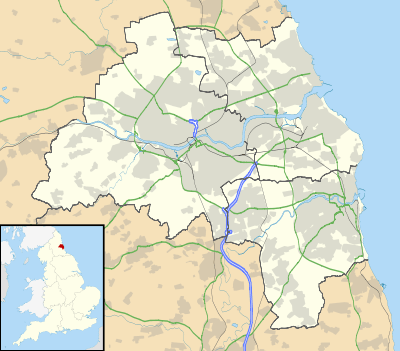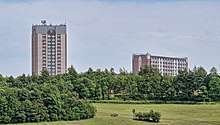Hebburn
| Hebburn | |
|---|---|
 Hebburn Hebburn shown within Tyne and Wear | |
| Population | 16,492 (2011. South Tyneside Wards) |
| OS grid reference | NZ318645 |
| Metropolitan borough | |
| Metropolitan county | |
| Region | |
| Country | England |
| Sovereign state | United Kingdom |
| Post town | HEBBURN |
| Postcode district | NE31 |
| Dialling code | 0191 |
| Police | Northumbria |
| Fire | Tyne and Wear |
| Ambulance | North East |
| EU Parliament | North East England |
| UK Parliament | |
Hebburn is a small town situated on the south bank of the River Tyne in North East England sandwiched between the towns of Jarrow and Gateshead and to the south of Walker. The population of Hebburn was 18,808 in 2001,[1] reducing to 16,492 at the 2011 Census for the 2 Hebburn Wards (North & South).[2][3]
History

Historically part of County Durham, it is thought that the name Hebburn may be derived from the Old English terms, heah meaning "high", and byrgen meaning a "burial mound", though it could also mean the high place beside the water. The first record of Hebburn mentions a settlement of fishermen's huts in the 8th century, which were burned by the Vikings.
Local legend claims that, until recently, a preserved longship lay embedded on the south bank of the Tyne at Hebburn. The object, visible at low tide, was however the remains of an old wooden "coal lighter". A genuine longship would likely have been salvaged by a historical society, or have had a protection order placed upon it.
In the 14th century the landscape was dominated by a peel tower. A 4-foot-6-inch-tall (137-centimetre) wall, a portion of which still remains at St. John's Church, could also be seen.[4] The Lordship of the Manor of Hebburn passed through the hands of a number of families during the Middle Ages, including the Hodgsons of Hebburn (James 1974, Hodgson).
Coal was mined at Hebburn as early as the 17th century. Hebburn Colliery opened in 1792 and eventually operated three pits. It closed in 1932. 200 miners were killed during the life of the colliery.[5] The youngest were 10 years old. Hebburn Colliery played an important role in the investigations into the development of mine safety, following the mining disaster at Felling Colliery in 1812. Humphry Davy stayed with Cuthbert Ellison at Hebburn Hall in 1815 and took samples of the explosive methane 'fire damp' gas from the Hebburn mine which were taken to London in wine bottles for experiments into the development of a miners' safety lamp. Davy's lamps were tested in the Hebburn mine and remarkably the gauze that protected the naked flames could actually absorb the fire damp so that the lamps could shine more effectively.[6]
Hebburn also hosted its own Highland Games, with the first one being held in 1883, which were usually held annually in July or August, spanning over three decades and with professional sportsmen coming from Scotland and as far as Oban to compete.
In 1936 Monkton Coke Works was built by the Government, in response to the Jarrow Hunger March in 1932. The plant closed in 1990, and was demolished in 1992.[7]
Hebburn also has a proud shipbuilding history with many Royal Navy battle ships being built at A. Leslie and Company. The most best known ship built at the ship yard was HMS Kelly,[8] launched in 1938 and commanded by Lord Louis Mountbatten.[9] One hundred and thirty men were killed when it was sunk and they are remembered in memorials at Hebburn Cemetery,[9] which were erected by surviving members of the crew and workers from Hawthorn Leslie.[9]
Hebburn once operated a mid Tyne ferry service.[10] The service was owned by various Tyne ship yards. The service ran between Hebburn, Walker and Wallsend.[10] The ferry service last operated in 1986.[10]
The former British Short-Circuit Testing Station in Victoria Road West within the town, owned by A. Reyrolle & Company provided the backdrop for the Gary Numan video "Metal". The facility was demolished in 2011.[11]
Hebburn Town F.C., formed in 1912,[12] and Hebburn Reyrolle F.C. are the town's local non-league football teams. Hebburn Argyle, which existed in the early 1900s, reformed several years ago as a youth club.
Athletics is also catered for at Monkton Stadium, home of Jarrow and Hebburn Athletic Club,[13] where Brendan Foster, Steve Cram and David Sharpe are notable past runners.
The Parachute Regiment 4th Para Reserves have a base in Hebburn.
The Air Cadets have a unit located at Hebburn TA Centre.[14]
Hebburn has an ecology centre powered by wind turbines.
It is the location of a shipyard, operated by A&P Group.[15]
In 2012, the BBC commissioned a television series Hebburn to be set in the town. It was created and co-written by Jason Cook, who was raised in Hebburn.[16] The first episode was broadcast on 18 October 2012.[17][18]
Hebburn has two secondary schools St Joseph's Catholic Academy (formerly St Joseph's Comprehensive School) and Hebburn Comprehensive School.[19]
Transport
It has a station on the Tyne and Wear Metro called Hebburn Metro station. Frequent bus services to South Shields, Jarrow, Gateshead and Newcastle are available to catch on Station Road.
Notable citizens
- George Armstrong: Football player with Arsenal F.C.[20][21]
- Chris Basham: Football player with Blackpool F.C., Bolton Wanderers F.C and Sheffield United F.C
- Dominic Bruce: Escaped from Colditz Castle[22]
- Ian Chipchase : Athlete and Gold medalist at the 1974 Commonwealth Games
- Jason Cook: Comedian, writer of the BBC sitcom Hebburn
- Josef Craig: British Paralympic Swimmer, who won Gold at the 2012 Paralympic Games.
- Johnny Dixon: Football player with Aston Villa F.C.
- Jack English: Football player
- Carl Finnigan: Football player with St Johnstone F.C, Falkirk F.C. and Newcastle United F.C
- Brendan Foster: Athlete and Sports commentator
- Arthur Holmes: Geologist
- Andrew Leslie: Shipbuilder[23]
- Wilfred Milne: Football player
- Sir Fergus Montgomery: Conservative MP and Margaret Thatcher's Parliamentary Private Secretary
- Robert Saint: Composer best known for his musical composition “Gresford”, also known as “The Miners Hymn”.
- Professor Brian David Smith: Academic Researcher
- Frank Wappat: BBC Radio Presenter and Disc Jockey
- John Steven Watson: English historian
- Ray Wood: Football player with Manchester United F.C.
- Professor Paul Younger: Hydrogeologist and Environmental Engineer
References
- ↑ Office for National Statistics : Census 2001 : Urban Areas : Table KS01 : Usual Resident Population DMM - Hebburn Colliery
- ↑ "Hebburn south ward population 2011". Retrieved 6 July 2015.
- ↑ "Hebburn north ward population2011". Retrieved 6 July 2015.
- ↑ Staff (1 January 2012). "Eight interesting facts about Hebburn". Evening Chronicle. Newcastle: chroniclelive.co.uk. Retrieved 30 July 2018.
- ↑ "Hebburn Colliery". dmm.org.uk. Retrieved 30 July 2018.
- ↑ Henderson, Tony (24 June 2016). "From The Cokeys to Spuggies' Bridge: 17 things you'll know if you're from Hebburn". Chronicle. Newcastle: chroniclelive.co.uk. Retrieved 30 July 2018.
- ↑ "Demolition of Monkton Cokeworks". southtynesidehistory.co.uk. Retrieved 2 October 2018.
- ↑ "Hebburn, Hawthorn Leslie Shipyard - sitelines.newcastle.gov.uk". twsitelines.info. Retrieved 28 June 2015.
- 1 2 3 Morton, David (26 August 2017). "The tragic World War II ship which is forever linked to a Tyneside town". Chronicle. Newcastle: chroniclelive.co.uk. Retrieved 27 April 2018.
- 1 2 3 Morton, David (3 September 2015). "The Tyne ferries that have carried thousands of passengers for generations". Chronicle. Newcastle: chroniclelive.co.uk. Retrieved 5 May 2018.
- ↑ "Former Reyrolle site set to disappear". shieldsgazette.com. Retrieved 28 June 2015.
- ↑ "History". hebburntownfc.co.uk. Retrieved 28 June 2015.
- ↑ Jarrow and Hebburn AC
- ↑ "1027 (Jarrow) Squadron". 1027sqn.org. Retrieved 28 June 2015.
- ↑ Gibson, Robert (6 May 2016). "20,000 tonne wind turbine installation vessel docks at A&P Group's Tyne yard". Chronicle. Newcastle: chroniclelive.co.uk. Retrieved 29 April 2018.
- ↑ Dipper, Andrew (2 September 2012). "Interview: Hebburn creator Jason Cook". Giggle Beats. Retrieved 1 December 2012.
- ↑ Lawson, Ruth. "Jason Cook's pilot show 'Hebburn' commissioned". The Chronicle.
- ↑ "Hebburn". BBC.
- ↑ "Hebburn Comprehensive School, South Tyneside". hebburn.net. Retrieved 28 June 2015.
- ↑ Glanville, Brian (2 November 2000). "George Armstrong - Professional footballer who played with courage and generosity". The Guardian. London: theguardian.com. Retrieved 29 April 2018.
- ↑ "Football mourns death of Geordie", The South Shields Gazette, South Shields, 2 November 2000, retrieved 24 June 2010
- ↑ Hunt, Philip A. (1988). Biographical Register 1880-1974 Corpus Christi College (University of Oxford). Oxford, England: The College. ISBN 9780951284407.
- ↑ "Working Lives". google.co.uk. Retrieved 28 June 2015.
Bibliography
James, Mervyn (1974) Family, Lineage, and Civil Society: A Study of Society, Politics, and Mentality in the Durham Region, 1500-1640 (Oxford: Oxford University Press).
External links
| Wikimedia Commons has media related to Hebburn. |
- South Tyneside Council & Community website - Local council website
- Hebburn Colliery - Information about Hebburn Colliery
- Hebburn.org - Site detailing history of the town